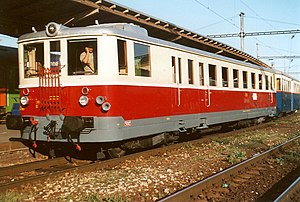ČSD series M 262.0
| ČSD series M 262.0, M 262.1 ČD series 830, 831 |
|
|---|---|
|
sewing machine
|
|
| Numbering: | M 262.0001-0250 |
| Number: | 250 |
| Manufacturer: |
Královopolská , Brno Vagónka Tatras , Studénka |
| Year of construction (s): | 1948 prototype 1949–1960 series vehicles |
| Retirement: | 2011 |
| Axis formula : | Bo'2 ' |
| Gauge : | 1435 mm ( standard gauge ) |
| Length over buffers: | 21,236 mm |
| Service mass: | 52.2 t |
| Wheel set mass : | 13.0 t |
| Top speed: | 90 km / h |
| Installed capacity: | 302 kW |
| Motor type: | M 262.0 (830): KS 12 V 170 DR M 262.1 (831): 6 L 150 PV |
| Power transmission: | electric |
| Number of traction motors: | 2 |
| Seats: | 56 |
| Classes : | 2. |
The M 262.0 series (from 1988: 830 series ) is a four-axle diesel multiple unit for regional and express train services of the former Czechoslovak State Railways ČSD.
history
The M 262.0 series railcars were produced in 250 units from 1949 to 1960 by Královopolská , Brno and Tatra Studénka and delivered to the ČSD. The vehicles up to number 052 were manufactured by Královopolská, the remaining vehicles were then manufactured by Vagonka Studénka . The appearance changed several times. The vehicles manufactured by Královopolská had the box with the flat roof, the grilles as transition protection, the large front windows and the arrangement of the tail lights above the headlights. The first vehicles manufactured by Studénka (from company number 053 to 140) still had the appearance of the first vehicles from Královopolská with the flat barrel roof, the transition grilles and the large front windows, only here the tail lights were placed under the headlights. From road number 141, the vehicles then carried the arched barrel roof with sheet metal as transition protection and smaller front windows. From this design on, the railcars also received one of their many nicknames; Kredenc (German: kitchen cabinet ).
The vehicles were powered by the 12 V 170 DR engine with an output of 302 kW and had electrical power transmission. The output of the generator is 260 kW, the two drive motors each have 130 kW. Some vehicles were equipped with new engines in the Šumperk repair shop in the early 1980s and classified in the 831 series.
The M 262.0 series railcars have shaped passenger and express train service on non-electrified routes with medium traffic for decades. In Germany they became known through the corridor traffic between Varnsdorf and Liberec via Zittau . The robust, reliable and undemanding vehicles enjoyed great popularity with staff and travelers. Because of the noise they make when driving, they were nicknamed “sewing machines”.
One of the last operational routes of the vehicles was the current timetable route 073 Děčín - Ústí nad Labem - Střekov until 2006 . The last vehicles were used on the Jeseníky Mountains in 2011 and retired in Šumperk in the same year .
The railcars of the M 262.0 series were, along with the Romanian Malaxa railcars, the oldest diesel railcars in regular service in Europe. Some specimens have been in use for over 60 years. Many of the vehicles have been preserved, some of them in working condition for clubs.
See also
- List of locomotive and multiple unit series of the ČSD
- List of locomotive and multiple unit series of the ŽSR
- List of the ČD locomotive and multiple unit series
literature
- Martin Šmida: Vagonka Ve Studence, Motorove Vozy, Motorove a Elektricke Lokomotivy 1927–2000. Vagonařske Muzem Studenka, 2012. (Czech)
Web links
gallery
Starting railcar 831 183 2010 in the Šumperk locomotive depot
View of the 830 076 with car body from Vagonka Studenka
View of the M 262 043 with car body from Královopolská
Individual evidence
- ↑ Page on the use of the M 262.0 series railcars at KŽC Doprava ( Memento from November 13, 2015 in the Internet Archive )







